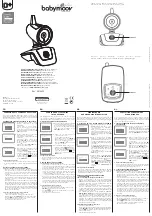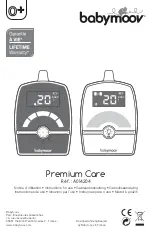
3
BP AG1-10
EN
5. Always ensure that the correct cuff size is used (marking on the
cuff).
Fit the cuff closely, but not too tight.
Make sure that the cuff is positioned 1-2 cm above the
elbow.
The
artery mark
on the cuff (ca. 3 cm long bar) must lie over
the artery which runs down the inner side of the arm.
Support your arm so it is relaxed.
Ensure that the cuff is at the same height as your heart.
6. Any improper setup or damage to the stethoscope will cause
distorted sound or poor sound transmission causing inaccurate
readings.
7.
Proper deflation rate is essential for an accurate reading.
Practice and master a recommended deflation rate of 2-3 mmHg
per second or a drop of 1-2 marks on the manometer
1
for each
heartbeat.
Measuring procedure
1. Place the chest piece underneath the cuff
2
or 1-2 cm below
it. Make sure the chest piece is in contact with the skin and lies
on the brachial artery.
2. Plug in the ear piece and check, if the chest piece is placed
correctly, so that the Korotkoff sounds appear the loudest.
3. Close the valve
4
on the pump ball
3
by turning the screw
clockwise. Do not over-tighten.
4. Take the pump ball
3
in your free hand (the arm you are not
using to measure) and pump up the cuff. Watch the pressure indi-
cator on the manometer
1
and pump up to approx. 40 mmHg
higher than the expected systolic value (the upper value).
Inflate to 200 mmHg if you are not sure about the expected
value.
5. Open the valve
4
slowly by turning the screw counter clock-
wise whilst holding the stethoscope chest piece on the brachial
artery. Listen carefully as the cuff begins to deflate. Note the
reading on the manometer
1
as soon as you hear a faint,
rhythmic tapping or thumping sounds.
This is the systolic
blood pressure reading.
6. Allow the pressure to continue dropping at the same deflation
rate. Note the reading on the manometer
1
as soon as the
thumping sound stops.
This is the diastolic blood pressure
reading.
7. Deflate the cuff completely.
8. Repeat the measurement at least two further times and record
your values, date and time immediately after finishing the
measurements.
9. Remove the cuff and the stethoscope.
4. Malfunction / Troubleshooting
If problems occur when using the device, the following points
should be checked and if necessary, the corresponding measures
are to be taken:
If you think the results are unusual, please read through the
information in «Section 1.» carefully.
Description
Potential cause and remedy
The sound transmis-
sion is poor, distorted
or there is extraneous
noise.
Check the ear pieces if they are dirty
or cracked. If not, make sure you
wear them properly.
Check the tube if it is broken or
twisted.
Check the chest piece if there is any
damage.
Make sure the chest piece is in
contact with the skin and lies on the
brachial artery. Clean or replace any
defective parts if found to avoid inac-
curate reading.
The pressure does not
rise although the pump
ball
3
is pumping.
Make sure that the valve is closed.
Make sure the cuff is properly
connected to bulb and manometer.
Check if the cuff, tube and/or bulb is
leaking. Replace the defective parts
if any.
The deflation rate can
not be set to 2-
3 mmHg/sec. by
adjusting the valve
4
.
Disassemble the valve from pump ball
to check if there is any blockage in the
airway of the valve. Clean the blockage
and try again. If it still does not work,
replace it to avoid inaccurate readings.
The manometer needle
is not at 0 ± 3 mmHg at
rest.
Make sure that the valve is
completely open for zero check.
If still more than 3 mmHg deviation,
contact your dealer to recalibrate the
manometer.
Summary of Contents for BP AG1-10
Page 13: ...11 BP AG1 10 FR...
Page 19: ...17 BP AG1 10 IT...
Page 22: ...20 1 2 1 2 2 3 3 4 3 4 3 1 40 E 200 5 4 3 1 6 3 1 7 8 9 4 E 1 3 2 3 4 E 0 3 E 3...
Page 23: ...21 BP AG1 10 RU 5 300 2 Microlife 6 2 Microlife Microlife Microlife www microlife ru support...
Page 25: ...23 BP AG1 10 RU...
Page 35: ...33 BP AG1 10 HR...
Page 38: ...36 2 3 mmHg 1 2 1 1 2 1 2 2 3 4 3 4 3 1 40 200 5 4 1 6 1 7 8 9 4 1 3 4 2 3 0 3 3...
Page 41: ...39 BP AG1 10 BG...
Page 47: ...45 BP AG1 10 RO...
Page 49: ...47 BP AG1 10 AR ESH ESC JSH _...
Page 50: ...48...
Page 53: ...51 BP AG1 10 FA mmHg ESH ESC JSH mmHg _ 86082261...
Page 54: ...52 mmHg mmHg...
Page 55: ...53 BP AG1 10 FA mmHg 86082261 86082261 www microlife com support C mmHg C mmHg...
Page 56: ...54 mmHg mmHg EN ISO 81060 1 ANSI AAMI SP09 Directive 93 42 EEC...
Page 57: ...55 BP AG1 10 FA...






































